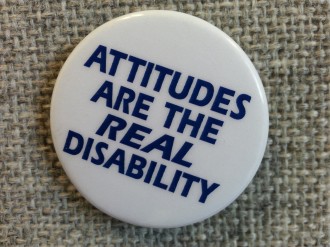Making an Attitudinal Change to Disabilities
One of the library buttons pinned on my office wallboard conveys a simple truth: “Attitudes are the real disability.”
My original plan this month was to write about “Outreach to People with Disabilities.” Yet that subject was soon replaced by a topic that preempts and precedes the concept of disability outreach: attitudinal barriers to library accessibility. While none of us sets out to block library accessibility with our attitude, attitude does in fact inform decisions about all library products and services. This mindset may unconsciously affect planning for library remodels and new facilities; how we present our physical and virtual collections; how we plan and market public programs; how we determine assistive technology needs, and whether to conduct outreach to people with disabilities. Attitude has a direct bearing on how we deliver all of our library products and services, but disability awareness should inform and support our ability to provide the best library service and materials possible.
Taking steps to include people of all abilities in public library programs and activities changes the outlook of both staff and visitors. We know in our personal lives that attitude shapes our thoughts and motives, so why would it not also affect decisions we make for our libraries? The goal of this discussion is to bring attitude into our awareness radar. Library accessibility first requires the level of awareness that places us as leaders in access, rather than reactors to accessibility issues. The difference between leading in access and reacting to accessibility begins with disability awareness. Considering the needs for all types of learners when planning library programs, activities, materials, and online services promotes the idea that increased access for people with disabilities means increased access for all. Planning for library accessibility opens doors to diverse and broad community connections. Moreover, it ensures people get connected with libraries, our goal!
Libraries that address access concerns during planning phases will face fewer challenges that result from accessibility blunders. Some of the most common reasons we review accessibility in our libraries include: Strategic priorities, legal requirements; demand from an individual or groups; or the topic is trending and brings renewed awareness. Most hasty accessibility quick fixes could be avoided if attitudes were honed for inclusion from the beginning. This not only applies to facility access, but when planning story times and other popular programs. Since we know that nearly 20% of the US population has one or more disabilities, we can assume people in our communities appreciate efforts toward access and inclusion. It’s not that libraries intentionally set out to ignore access issues, but inclusivity may not be considered early enough in the process of planning, training, and implementation of programs and activities. When accessibility demands originate from an individual or group, we often react as a result of that demand and consider it fixed until further notice. With library accessibility planted in the forefront of our minds, we will be ready to provide programs and services for people with disabilities before they are requested.
We can make huge strides in library accessibility beginning with our own attitude. Customer service delivered with the right attitude, one of inclusion and acceptance, can be easily accomplished. What will be remembered by library visitors is the attitude library staff conveyed, not the information shared. Consider the following attitudinal helps for providing a welcoming library experience:
- Share a friendly face
- Converse with a nonjudgmental look
- Provide encouragement and acceptance during the reference interview
- Make eye contact
- Acknowledge the importance of the person and their information request
- Abandon assumptions about physical or intellectual disabilities in favor of making a personal connection
- Relax and throw away fears that stem from lack of expertise
Source:
Nearly 1 in 5 People Have a Disability in the U.S., Census Bureau Reports, https://www.census.gov/newsroom/releases/archives/miscellaneous/cb12-134.html
Tags: accessibility, attitude, disability, programming, staff training








